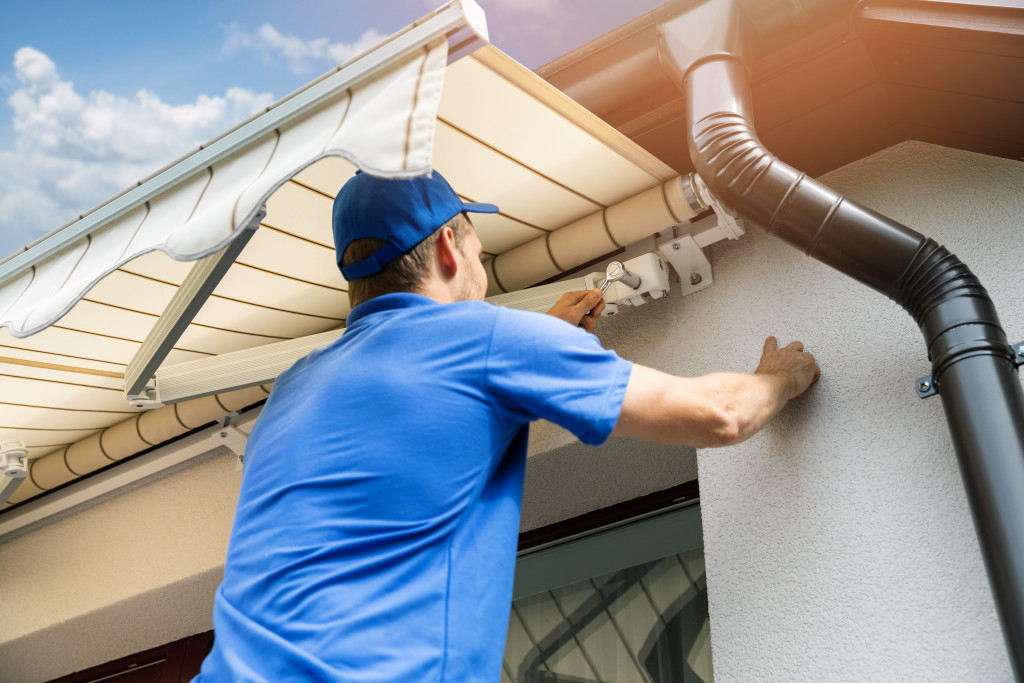Many homeowners are constantly working to improve their homes to boost their value while simultaneously increasing their comfort. Adding a patio in the backyard is one home renovation that accomplishes both goals. This helps to create extra living space outdoors. However, this leaves the patio exposed to extreme weather changes, temperature, dirt, and other elements. This means that your wooden deck is exposed to the harshness of rain and moisture too.
Needless to say, your patio needs TLC before, during, and after a heavy downpour. Usually, the wood boards absorb the water after a rainy day, but the sunlight easily remedies prolonged exposure. The sun will help dry up the wood faster. But when your patio floor gets wet more often, it can damage the quality and put its durability to the test.
Minimize or prevent the damage your patio floors could get from this exposure through these tips. Give your patio a thorough clean at least three times a year to get rid of abrasive elements and signs of neglect.

1. Clear the Patio
A great place to start is clearing your patio floor of any leaves, twigs, and debris. This includes any furniture too. To get the proper restart your patio needs, you should start with a clean canvas. Sweep or air blow particles and debris off the patio. Take your time in inspecting its surface, and keep an eye out for any signs of mold and rot. Be sure to address these problematic areas accordingly to prevent these from spreading or worsening. Wood rot, in particular, can be caused by frequent contact with water and moisture. The decaying areas can be challenging to deal with and usually require you to shell out some extra time and money.
2. Clean the Patio Thoroughly
There are multiple things you can use to clean your patio. But a store-bought cleaning solution and a hose or pressure washer can do the trick. Be sure to read the cleaning instructions and use a brush to distribute the solution evenly throughout the wood’s surface. Leave it for the amount of time instructed. Afterward, use a hose or a pressure washer (in the low to medium setting) to wash away the solution.
3. Check for Loose or Protruding Parts
Minor issues such as a loose board or patio screws are easily fixable. Make sure to check for protruding nails or screws to prevent any injuries. Furthermore, address any loose boards as soon as possible. With sandpaper, sand down imperfections on the patio’s surface. After sanding, sweep or hose down the area to remove any dust. This is also essential prep for resealing.
4. Restain and Reseal
Many homeowners use power washers to clean their patio, which is ideal for eliminating stubborn stains. The issue is that it may also remove whatever sealer or wood stain you’ve applied previously. So after power washing your patio, make sure to restrain and reseal as necessary.
It’s important to remember that after you’ve cleaned the wood, it can retain moisture. Allow two to three days before applying any sealants to prevent moisture from being trapped inside the wood. Moisture trapped inside the wood can eventually cause it to rot.
5. Install Enclosures for Better Protection
If you don’t have enclosures for your patio yet, consider having them installed. Enclosures are great for minimizing exposure to extreme temperatures, as well as other outdoor elements that can damage and shorten the lifespan of your patio. But if you already have them, don’t forget to give them some care, too.
6. Sweep Your Patio Floor Regularly
If you sweep any other part of your home, doing the same for your patio shouldn’t be any different. If your deck doesn’t have enclosures, this is an essential step in managing it. Although dust and debris seem to be nothing but nuances, the buildup can create scratches and scuff marks on the wood. Sweeping also provides the opportunity to inspect your patio’s floor. This way, you can maintain it more effectively.
7. Choose Quality Wood for Your Patio
If building a patio is a project you want to take on in the future, it pays to know which type of wood is best for your patio. Getting high-quality wood for this project will prove worth it in the long run. Wooden boards that are weather-resistant, long-lasting, and attractive are ideal, especially if they are exposed to outdoor elements 24/7. Some wood species are more durable than others, so knowing which ones are worth the money is essential.
Conclusion
A homeowner’s desire to extend the life of their patio is understandable. One of the ultimate ways to achieve that is to learn how to take care of it, particularly before, during, and after extreme conditions. By being meticulous about this routine, a patio will undoubtedly continue to see good days ahead.





